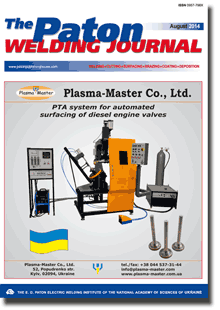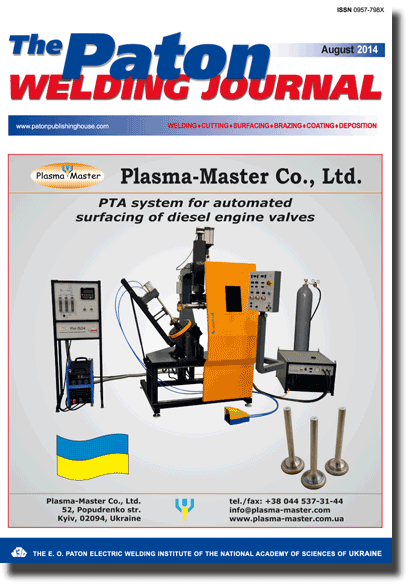| 2014 №08 (01) |
DOI of Article 10.15407/tpwj2014.08.02 |
2014 №08 (03) |

The Paton Welding Journal, 2014, #8, 15-20 pages
REGULARITIES OF CREATION OF MODIFIED INTERLAYERS IN USING OF HIGHLY-CONCENTRATED ENERGY FLOWS
V.F. KVASNITSKY1, V.V. KVASNITSKY2, N.N. CHERENDA3, N.N. KOVAL4 and I.L. LEVCHENKO2
1Admiral Makarov National Shipbuilding University. 9 Geroev Stalingrada Ave., 54025, Nikolaev, Ukraine. E-mail: welding@nuos.edu.ua
2NTUU «Kiev Polytechnic Institute». 37 Pobedy Ave., 03056, Kiev, Ukraine. E-mail: kvas69@ukr.net
3Belarusian State University. 4 Nezavisimosti Ave., 220030, Minsk, Belarus. E-mail: cherenda@bsu.by
4Institute of High Current Electronics, SB RAS. 2/3 Akademichesky Ave., 634055, Tomsk, Russia. E-mail: contact@hcei.tsc.ru
Abstract
Radiation-beam technologies applied for modifying, including those with alloying of surfaces, provide necessary topography of surface, its activation, improvement of adhesion properties, required structure and chemical composition of the surface. These characteristics are further determining in diffusion welding, brazing and deposition of coatings. In the work the low-energy high-current electron beams and high-energy plasma flows for modifying and alloying of the joined surfaces of steels and heat-resistant alloys were used. These types of surface treatment belong to the radiation-beam technologies. The treatment was carried out using low-energy high-current electron beams in vacuum 10-2 Pa in the installation SOLO of the Institute of High Current Electronics of the SB RAS, and also high-energy plasma flows using magnetic plasma compressor of a compact geometry of the Belarusian State University at the pressure of hydrogen and nitrogen of 3x102 Pa, and welding and brazing were performed in the installation UDSV-DT in vacuum of 10-2 Pa or super-high vacuum universal technological complex VVU-1D in vacuum of 10-5 Pa. Independently of metals being investigated the formation of sub-microcrystalline structure, presence of high density of dislocations (up to 1011 cm-2), appearance of stresses of the 3rd kind, being the evidence of immense increase in level of energy accumulated in modified layer, are characteristic for all the modified layers. The surfaces of heat-resistant nickel alloys were alloyed by zirconium and hafnium, which are the most challenging depressants of nickel brazing alloys. For this purpose the layers of alloying element of 1-3 mm thickness was deposited on the surface using method of ion-plasma spraying and then the surface layer was remelted using low-energy high-current electron beams and high-energy plasma flows. The investigations of processes of formation of modified and alloyed surfaces showed the possibility of efficient control of structure and composition of the modified layer. Diffusion welding in a solid state and with a melting interlayer provides the high quality of joints, which can be confirmed by the structures and mechanical properties of joints. The application of radiation-beam technologies allows expanding the capabilities of joining metals and hardening the materials. 13 Ref., 6 Figures.
Keywords: surface modifying, electron beam, high-power plasma flow, diffusion welding, brazing
Received: 30.05.14
Published: 28.08.14
References
1. Gribkov, V.G., Grigoriev, F.I., Kalin, B.A. et al. (2001) Advanced radiation-beam technologies for treatment of materials: Manual. Ed. by B.A. Kalin. Moscow: Krugly God.
2. Kvasnitskii, V.V., Kuznetsov, V.D., Koval, N.N. et al. (2009) A high-current electron beam application for the surface modification of iron. Stainless steel and heat resistant alloys. Surface Eng. and Applied Electrochem., (45)3, 180-185. https://doi.org/10.3103/S1068375509030028
3. Kvasnitsky, V.F., Kvasnitsky, V.V., Cherenda, N.N. et al. (2011) Effect of surface modification using concentrated energy beams on formation of solid phase joints. In: Proc. of 9th Int. Conf. on Interaction of Emissions with Solid (Minsk, 20 Aug.-2 Sept., 2011), 228-230. Minsk: Tsentr BGU.
4. Belov, A.B., Britsenko, O.A., Krajnikov, A.V. et al. (2012) High-current pulsed electron beams for aeronautical engine engineering. Moscow: DIPAK.
5. Musin, R.A., Antsiferov, V.N., Kvasnitsky, V.F. (1979) Diffusion welding of heat-resistant alloys. Moscow: Metallurgiya.
6. Ermolaev, G.V., Zhitnikov, N.P., Zabolotsky, V.M. et al. (1988) Vacuum diffusion welding of dispersion-hardened heat-resistant alloys with inserts. Sudostroit. Promyshlennost, Series Welding, Issue 6, 13-23.
7. Cherenda, N.N., Uglov, V.V., Kvasnitsky, V.F. et al. (2014) Elemental composition of surface layer of heat-resistant nickel alloy alloyed with zirconium atoms under action of compression plasma flows. Poverkhnost. Rentgen., Sinkhron. i Nejtron. Issledov., 2, 74-79.
8. Khorunov, V.F., Ivanchenko, V.G., Kvasnitsky, V.V. (1999) Structure and phase composition of Ni-Cr-Zr and Ni-Cr-Hf alloys applied as braze filler materials. Avtomatich. Svarka, 11, 14- 21.
9. Kvasnitsky, V.F., Kostin, A.M., Kvasnitsky, V.V. (2002) Effect of elements-depressants on properties of nickel braze materials and heat-resistant alloys. Adgeziya Rasplavov i Pajka Materialov, 35, 129-139.
10. Lugscheider, E., Bushke, I., Daichend, D.M. et al. (1998) Evaluiring des Eizatzpotential und rostfreien Edelstahlen. In: Vortrage und Posterbeitrage des 5. Kolloquium in der Hart- und Hochtemperaturloten und Diffusionsschweissen (Aachen, 16-18 June, 1998), 192, 242-245. Duesseldorf: DVS.
11. Zeng Yun-Rong, Ca Yu-Lin, Ruan Zong-Ci et al. (2006) Investigation of effect mechanism of hafnium and zirconium in high temperature materials. J. Aeronaut. Mat., 26(3), 25-34.
12. Sircars, S., Mazumder, J. (1989) Microstructure evolution and nonequilibrium phase diagram Ni-Hf binary alloy produced by laser cladding. Acta Metallurgica, 37(1), 1167-1176. https://doi.org/10.1016/0001-6160(89)90112-0
13. Zehg, Y., Ruan, Z. (1990) Microstructure and performance of Ni-Hf brazing filler alloy. Acta Metall. Sinica, 10, 335-340.
Suggested Citation
V.F. KVASNITSKY, V.V. KVASNITSKY, N.N. CHERENDA, N.N. KOVAL and I.L. LEVCHENKO (2014) REGULARITIES OF CREATION OF MODIFIED INTERLAYERS IN USING OF HIGHLY-CONCENTRATED ENERGY FLOWS. The Paton Welding J., 08, 15-20.The cost of subscription/purchase order journals or individual articles
| Journal/Currency | Annual Set | 1 issue printed |
1 issue |
one article |
| TPWJ/USD | 384 $ | 32 $ | 26 $ | 13 $ |
| TPWJ/EUR | 348 € | 29 € | 24 € | 12 € |
| TPWJ/UAH | 7200 UAH | 600 UAH | 600 UAH | 280 UAH |
| AS/UAH | 1800 UAH | 300 UAH | 300 UAH | 150 UAH |
| AS/USD | 192 $ | 32 $ | 26 $ | 13 $ |
| AS/EUR | 180 € | 30 € | 25 € | 12 € |
| SEM/UAH | 1200 UAH | 300 UAH | 300 UAH | 150 UAH |
| SEM/USD | 128 $ | 32 $ | 26 $ | 13 $ |
| SEM/EUR | 120 € | 30 € | 25 € | 12 € |
| TDNK/UAH | 1200 UAH | 300 UAH | 300 UAH | 150 UAH |
| TDNK/USD | 128 $ | 32 $ | 26 $ | 13 $ |
| TDNK/EUR | 120 € | 30 € | 25 € | 15 € |
AS = «Automatic Welding» - 6 issues per year;
TPWJ = «PATON WELDING JOURNAL» - 12 issues per year;
SEM = «Electrometallurgy Today» - 4 issues per year;
TDNK = «Technical Diagnostics and Non-Destructive Testing» - 4 issues per year.


